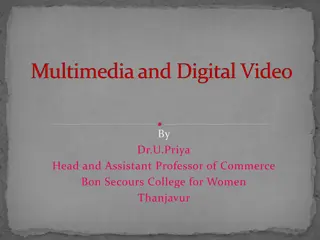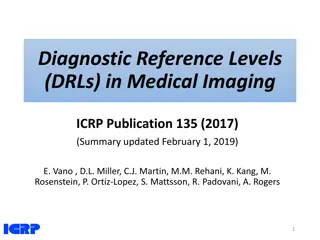Improved Imaging Compression with HTJ2K Transfer Syntax
Challenges with existing compression methods like JPEG 2000 have led to the development of High Throughput JPEG 2000 (HTJ2K), offering faster decoding speeds and support for advanced features like scalable resolution. HTJ2K resolves issues related to complexity, patent conflicts, and lack of open-source implementations. Its resolution scalability benefits enable dynamic image quality improvements and faster loading times. Changes made to HTJ2K include adding lossy and lossless transfer syntaxes to enhance performance in DICOM applications.
Download Presentation

Please find below an Image/Link to download the presentation.
The content on the website is provided AS IS for your information and personal use only. It may not be sold, licensed, or shared on other websites without obtaining consent from the author.If you encounter any issues during the download, it is possible that the publisher has removed the file from their server.
You are allowed to download the files provided on this website for personal or commercial use, subject to the condition that they are used lawfully. All files are the property of their respective owners.
The content on the website is provided AS IS for your information and personal use only. It may not be sold, licensed, or shared on other websites without obtaining consent from the author.
E N D
Presentation Transcript
Public Comment Overview: Supplement 235: HTJ2K Transfer Syntax DICOM WG-04 - Compression Bill Wallace, Radical Imaging Chris Hafey, Amazon Web Services
Challenges with Existing Compression JPEG 2000 has advanced features but has seen low adoption Significantly slower than other transfer syntax (at least 5x slower than JPEG-LS to decode) Advanced features require image to be encoded using specific parameters (e.g. scalable resolution requires RPLC progression order, certain number of decompositions) Very complex to implement correctly (several interoperability issues early on) Lack of availability of open source implementations for many years (paid commercial libraries was the only option) Concerns over patent conflicts (increased risk of litigation) JPEG Lossless and JPEG LS Do not support scalable resolution access Little to no gain from parallelization (not designed for this) WG-27 DICOMweb 2
HTJ2K Compression JPEG2000 was extended in 2019 with a new block coder that improves decode and encode speed by an order of magnitude. This variant of JPEG2000 is referred to as High Throughput JPEG2000 (HTJ2K) ISO/JPEG standard (https://jpeg.org/jpeg2000/htj2k.html) Free of patent conflicts, royalty free Strong Open Source support (OpenJPH, OpenJPEG, GROK, ffmpeg) Slightly lower compression ratios than JPEG2000 (~5%) Significantly faster at decoding than all compressed transfer syntaxes by at least 50% -> improved image display speed Supports most of the advanced JPEG2000 features (scalable resolution access in particular) Lower implementation complexity Learn more: https://github.com/chafey/HTJ2KResources WG-27 DICOMweb 3
Resolution Scalability HTJ2K Lossless CT Image - 140KB Total 128x128 (10KB) 256x256 (30KB) 512x512 (90KB) Decode/Render Decode/Render Decode/Render Download Viewer can dynamically improve the displayed image quality by decoding and rendering the image bitstream as it is received. This results in better user experiences, especially over lower and variable bandwidth network connections Decode/Render Download Viewer can display a 128x128 thumbnail of an image (e.g. series browser) by reading a small number of bytes (10K) of the bitstream. This results in faster initial loading, less bandwidth consumption and lower implementation complexity Try it out: https://chafey.github.io/openjphjs/test/browser/index.html Learn more: https://docs.google.com/document/d/1hMv75h8g5a8EvIopucdhElKdu7QGF1PgpAK4J1Ahvp4/edit?usp=sharing 4
Changes Overview Add lossy and lossless Transfer Syntaxes for HTJ2K Add constrained lossless Transfer Syntax to ensure applications can leverage scalable resolution features Add HTJ2K as a DICOMweb rendered media type for faster decoding and smaller image sizes WG-27 DICOMweb 5
Conclusions HTJ2K brings significantly faster image decoding for all image types -> faster image access The new constrained transfer syntax ensures HTJ2K images are encoded properly for scalable resolution access -> applications can confidently use this powerful feature WG-27 DICOMweb 6

 undefined
undefined




























